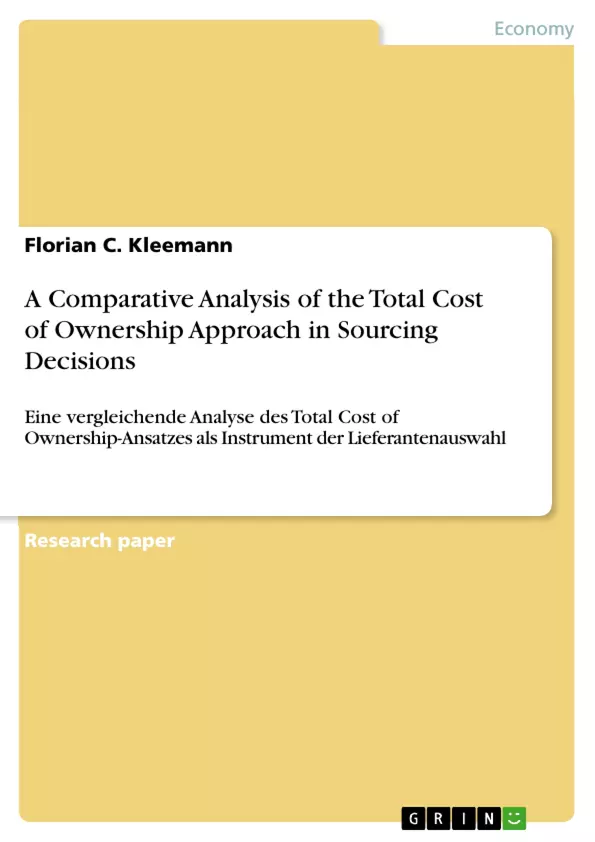Die Einkaufsfunktion gewinnt immer stärker an Bedeutung. Infolgedessen spielen Lieferanten eine immer wichtigere Rolle, womit sich besondere Anforderungen die Lieferantenauswahlentscheidung anknüpfen. Das „Total Cost of Ownership“-Konzept hat zum Ziel, eine umfassende Kostenbetrachtung für ein Beschaffungsobjekt vorzunehmen, um so eine fundierte Managemententscheidung zu ermöglichen. Die Arbeit stellt das TCO-Konzept zunächst allgemein vor und stellt es dann zwei weiteren Analysetools, der Lieferantenpreisanalyse und dem Target Costing (Zielkostensteuerung), gegenüber. So kann aufgezeigt werden, dass TCO ein zentraler Bestandteil des modernen Beschaffungsmanagements sind. Darauf basierend werden Anwendungsmöglichkeiten von TCO als Entscheidungsunterstützungsinstrument skizziert.
Inhaltsverzeichnis (Table of Contents)
- Introduction
- Comparing Cost-based Models for management decision making
- TCO: an overview
- Investigating the purchase price: an analysis of supplier costs.
- Target Costing – an end customer-oriented way of costing
- Cost Model Synopsis,
- TCO in strategic purchasing
- Conclusion
- References
- Bibliography.
Zielsetzung und Themenschwerpunkte (Objectives and Key Themes)
This paper aims to introduce the Total Cost of Ownership (TCO) concept and compare it to other cost models commonly used in management decision making. It explores the TCO approach as a tool to evaluate the costs associated with the purchase of goods or services, taking into account pre-transaction, transaction, and post-transaction costs. The paper further examines the application of TCO in strategic purchasing decisions, specifically related to supplier selection.
- The importance of the procurement function in modern business
- The evolution of procurement from a clerical function to a strategic decision-making process
- The limitations of considering only purchase price in procurement decisions
- The Total Cost of Ownership (TCO) approach and its components
- The application of TCO in supplier selection and strategic purchasing decisions
Zusammenfassung der Kapitel (Chapter Summaries)
The introduction highlights the increasing significance of the procurement function in companies due to globalization, competitive pressures, and outsourcing trends. It argues that the purchasing price alone is insufficient for making informed procurement decisions and introduces the TCO approach as a method to consider comprehensive costs related to a purchase. Chapter 2 compares the TCO model to other cost models, such as the analysis of supplier costs and target costing. It explores the various elements that constitute TCO, encompassing pre-transaction costs, transaction costs, and post-transaction costs. Chapter 3 delves into the implications of TCO for strategic purchasing decisions, particularly in the context of supplier selection. It examines how TCO analysis can guide companies in making strategic choices regarding suppliers. The conclusion summarizes the key findings of the paper, emphasizing the importance of TCO as a valuable tool for strategic purchasing and supplier selection decisions.
Schlüsselwörter (Keywords)
Strategic Purchasing, Procurement, Supplier Selection, Total Cost of Ownership, Cost Analysis, Target Costing, Strategic Decision Making, Supplier Relationship Management.
- Arbeit zitieren
- Florian C. Kleemann (Autor:in), 2011, A Comparative Analysis of the Total Cost of Ownership Approach in Sourcing Decisions, München, GRIN Verlag, https://www.grin.com/document/190104



